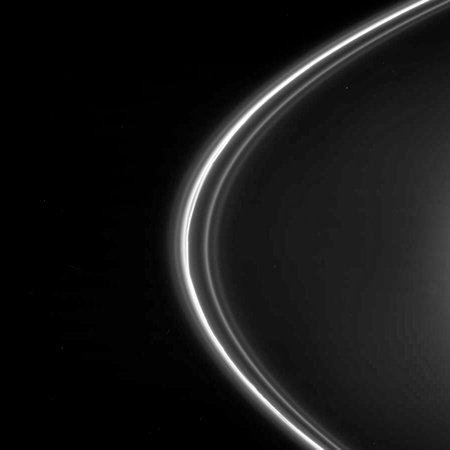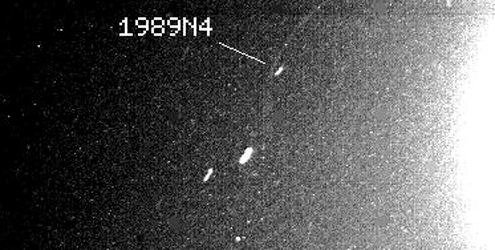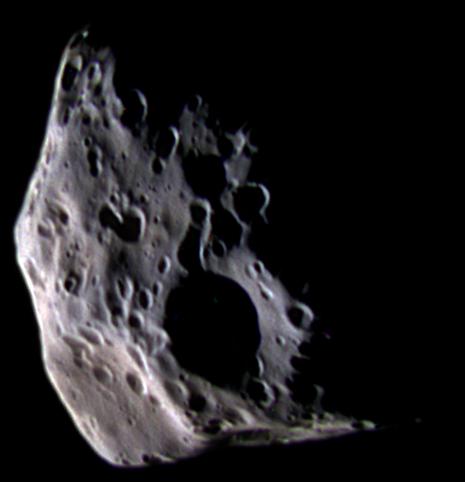|
Shepherd Moon
A shepherd moon (also herder moon or watcher moon) is a small natural satellite that clears a gap in planetary-ring material or keeps particles within a ring contained. The name is a result of the fact they limit the "herd" of the ring particles as a shepherd. Due to their gravitational effect, they pick up particles and deflect them from their original orbits through orbital resonance. This causes gaps in the ring system, such as the particularly striking Cassini Division, as well as other characteristic bands, or strange "twisted" deformation of rings. Discovery The existence of shepherd moons was theorized in early 1979. Observations of the rings of Uranus show that they are very thin and well defined, with sharp gaps between rings. To explain this, Goldreich and Tremaine suggested that two small satellites that were undetected at the time might be confining each ring. The first images of shepherd satellites were taken later that year by Voyager 1. Examples Jupiter Sev ... [...More Info...] [...Related Items...] OR: [Wikipedia] [Google] [Baidu] |
Prometheus (moon)
Prometheus is an inner satellite of Saturn. It was discovered in 1980 (on October 24) from photos taken by the ''Voyager 1'' probe, and was provisionally designated . In late 1985 it was officially named after Prometheus, a Titan in Greek mythology. It is also designated . Prometheus is extremely elongated, measuring approximately . It has several ridges and valleys and a number of impact craters of about diameter are visible, but it is less cratered than nearby Pandora, Epimetheus, and Janus. From its very low density and relatively high albedo, it is likely that Prometheus is a very porous icy body. There is much uncertainty in these values, however, and so this remains to be confirmed. Interactions with F Ring and other moons Prometheus is a shepherd satellite for the inner edge of Saturn's narrow F Ring. Pandora orbits just outside the F Ring, and has traditionally been viewed as an outer shepherd of the ring; however, recent studies indicate that only Prometheus con ... [...More Info...] [...Related Items...] OR: [Wikipedia] [Google] [Baidu] |
Galatea (moon)
Galatea , also known as Neptune VI, is the fourth-closest inner moon of Neptune. It is named after Galatea, one of the fifty Nereids of Greek legend, with whom Cyclops Polyphemus was vainly in love. Discovery Galatea was discovered in late July 1989 from the images taken by the ''Voyager 2'' probe. It was given the temporary designation S/1989 N 4. The discovery was announced (IAUC 4824) on 2 August 1989, and mentions "10 frames taken over 5 days", implying a discovery date of sometime before July 28. The name was given on 16 September 1991. Physical properties Galatea is irregularly shaped and shows no sign of any geological modification. It is likely that it is a rubble pile re-accreted from fragments of Neptune's original satellites, which were smashed up by perturbations from Triton soon after that moon's capture into a very eccentric initial orbit. Orbit Galatea's orbit lies below Neptune's synchronous orbit radius, so it is slowly spiralling inward ... [...More Info...] [...Related Items...] OR: [Wikipedia] [Google] [Baidu] |
Voyager 2
''Voyager 2'' is a space probe launched by NASA on August 20, 1977, to study the outer planets and interstellar space beyond the Sun's heliosphere. As a part of the Voyager program, it was launched 16 days before its twin, ''Voyager 1'', on a trajectory that took longer to reach gas giants Jupiter and Saturn but enabled further encounters with ice giants Uranus and Neptune. ''Voyager 2'' remains the only spacecraft to have visited either of the ice giant planets. ''Voyager 2'' was the fourth of five spacecraft to achieve Solar escape velocity, which allowed it to leave the Solar System. ''Voyager 2'' successfully fulfilled its primary mission of visiting the Jovian system in 1979, the Saturnian system in 1981, Uranian system in 1986, and the Neptunian system in 1989. The spacecraft is now in its extended mission of studying interstellar space. It has been operating for as of ; , it has reached a distance of from Earth. The probe entered interstellar space on November 5, 2 ... [...More Info...] [...Related Items...] OR: [Wikipedia] [Google] [Baidu] |
Rings Of Neptune
The rings of Neptune consist primarily of five principal rings. They were first discovered (as "arcs") by simultaneous observations of a stellar occultation on 22 July 1984 by André Brahic's and William B. Hubbard's teams at La Silla Observatory (ESO) and at Cerro Tololo Interamerican Observatory in Chile. They were eventually imaged in 1989 by the ''Voyager 2'' spacecraft. At their densest, they are comparable to the less dense portions of Saturn's main rings such as the C ring and the Cassini Division, but much of Neptune's ring system is quite tenuous, faint and dusty, more closely resembling the rings of Jupiter. Neptune's rings are named after astronomers who contributed important work on the planet: Galle, Le Verrier, Lassell, Arago, and Adams. Neptune also has a faint unnamed ring coincident with the orbit of the moon Galatea. Three other moons orbit between the rings: Naiad, Thalassa and Despina. The rings of Neptune are made of extremely dark material, likely or ... [...More Info...] [...Related Items...] OR: [Wikipedia] [Google] [Baidu] |
Neptune
Neptune is the eighth planet from the Sun and the farthest known planet in the Solar System. It is the fourth-largest planet in the Solar System by diameter, the third-most-massive planet, and the densest giant planet. It is 17 times the mass of Earth, and slightly more massive than its near-twin Uranus. Neptune is denser and physically smaller than Uranus because its greater mass causes more gravitational compression of its atmosphere. It is referred to as one of the solar system's two ice giant planets (the other one being Uranus). Being composed primarily of gases and liquids, it has no well-defined "solid surface". The planet orbits the Sun once every 164.8 julian year (astronomy), years at an average distance of . It is named after the Neptune (mythology), Roman god of the sea and has the astronomical symbol , representing Neptune's trident. Neptune is not visible to the unaided eye and is the only planet in the Solar System found by mathematical prediction ... [...More Info...] [...Related Items...] OR: [Wikipedia] [Google] [Baidu] |
Tidal Deceleration
Tidal acceleration is an effect of the tidal forces between an orbiting natural satellite (e.g. the Moon) and the primary planet that it orbits (e.g. Earth). The acceleration causes a gradual recession of a satellite in a prograde orbit away from the primary, and a corresponding slowdown of the primary's rotation. The process eventually leads to tidal locking, usually of the smaller body first, and later the larger body (e.g. theoretically with Earth in 50 billion years). The Earth–Moon system is the best-studied case. The similar process of tidal deceleration occurs for satellites that have an orbital period that is shorter than the primary's rotational period, or that orbit in a retrograde direction. The naming is somewhat confusing, because the average speed of the satellite relative to the body it orbits is ''decreased'' as a result of tidal acceleration, and ''increased'' as a result of tidal deceleration. This conundrum occurs because a positive acceleration at one instan ... [...More Info...] [...Related Items...] OR: [Wikipedia] [Google] [Baidu] |
Ophelia (moon)
Ophelia is a moon of Uranus. It was discovered from the images taken by ''Voyager 2'' on January 20, 1986, and was given the temporary designation S/1986 U 8. It was not seen until the Hubble Space Telescope recovered it in 2003. Ophelia was named after the daughter of Polonius, Ophelia, in William Shakespeare's play ''Hamlet''. It is also designated Uranus VII. Other than its orbit, radius of 21 km and geometric albedo of 0.08 virtually nothing is known about it. At the Voyager 2 images Ophelia appears as an elongated object, the major axis pointing towards Uranus. The ratio of axes of the Ophelia's prolate spheroid is 0.7 ± 0.3. Ophelia acts as the outer shepherd satellite for Uranus' ε ring. The orbit of Ophelia is within the synchronous orbit radius of Uranus, and is therefore slowly decaying due to tidal forces. See also * Moons of Uranus References Explanatory notes Citations External links Ophelia ProfilebNASA's Solar System Explorati ... [...More Info...] [...Related Items...] OR: [Wikipedia] [Google] [Baidu] |
Cordelia (moon)
Cordelia is the inner satellite, innermost known moon of Uranus. It was discovered from the images taken by ''Voyager 2'' on January 20, 1986, and was given the temporary designation S/1986 U 7. It was not detected again until the Hubble Space Telescope observed it in 1997. Cordelia takes its name from the youngest daughter of Lear in William Shakespeare's ''King Lear.'' It is also designated Uranus VI. Other than its orbit, radius of 20 km and geometric albedo of 0.08 virtually nothing is known about it. In the Voyager 2 images Cordelia appears as an elongated object with its major axis pointing towards Uranus. The ratio of axes of Cordelia's prolate spheroid is 0.7 ± 0.2. Cordelia acts as the inner shepherd satellite for Uranus' Rings of Uranus#ε ring, ε ring. Cordelia's orbit is within Uranus' synchronous orbit radius, and is therefore slowly decaying due to tidal deceleration. Cordelia is very close to a 5:3 orbital resonance with Rosalind (moon), Rosa ... [...More Info...] [...Related Items...] OR: [Wikipedia] [Google] [Baidu] |
Epsilon Ring
The rings of Uranus are intermediate in complexity between the more extensive set around Saturn and the simpler systems around Jupiter and Neptune. The rings of Uranus were discovered on March 10, 1977, by James L. Elliot, Edward W. Dunham, and Jessica Mink. William Herschel had also reported observing rings in 1789; modern astronomers are divided on whether he could have seen them, as they are very dark and faint.(re study by Stuart Eves) By 1977, nine distinct rings were identified. Two additional rings were discovered in 1986 in images taken by the ''Voyager 2'' spacecraft, and two outer rings were found in 2003–2005 in Hubble Space Telescope photos. In the order of increasing distance from the planet the 13 known rings are designated 1986U2R/ζ, 6, 5, 4, α, β, η, γ, δ, λ, ε, ν and μ. Their radii range from about 38,000 km for the 1986U2R/ζ ring to about 98,000 km for the μ ring. Additional faint dust bands and incomplete arcs may exist between the ma ... [...More Info...] [...Related Items...] OR: [Wikipedia] [Google] [Baidu] |
Uranus
Uranus is the seventh planet from the Sun. Its name is a reference to the Greek god of the sky, Uranus (mythology), Uranus (Caelus), who, according to Greek mythology, was the great-grandfather of Ares (Mars (mythology), Mars), grandfather of Zeus (Jupiter (mythology), Jupiter) and father of Cronus (Saturn (mythology), Saturn). It has the third-largest planetary radius and fourth-largest planetary mass in the Solar System. Uranus is similar in composition to Neptune, and both have bulk chemical compositions which differ from that of the larger gas giants Jupiter and Saturn. For this reason, scientists often classify Uranus and Neptune as "ice giants" to distinguish them from the other giant planets. As with gas giants, ice giants also lack a well defined "solid surface." Uranus's Atmosphere#Others, atmosphere is similar to Jupiter's and Saturn's in its primary composition of hydrogen and helium, but it contains more "volatiles, ices" such as water, ammonia, and methane, al ... [...More Info...] [...Related Items...] OR: [Wikipedia] [Google] [Baidu] |
Epimetheus (moon)
Epimetheus is an inner satellite of Saturn. It is also known as Saturn XI. It is named after the mythological Epimetheus, brother of Prometheus. Discovery Epimetheus occupies essentially the same orbit as the moon Janus. Astronomers assumed that there was only one body in that orbit (disbelieving that two moons could share nearly identical orbits without colliding), and accordingly had difficulty determining their orbital characteristics. Observations were photographic and spaced widely apart in time, so that while the presence of two objects was not obvious, the observations were difficult to reconcile with a reasonable orbit. Audouin Dollfus observed a moon on 15 December 1966, which he proposed to be named "Janus". On 18 December, Richard Walker made a similar observation which is now credited as the discovery of Epimetheus. However, at the time, it was believed that there was only one moon, unofficially known as "Janus", in the given orbit. Twelve years later, in ... [...More Info...] [...Related Items...] OR: [Wikipedia] [Google] [Baidu] |




